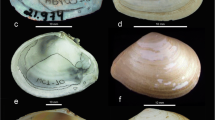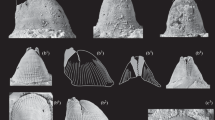Abstract
The practice of classifying articulate brachiopods, including Terebratulida, from minor morphological features and internal structures has led to a proliferation of genera and species, especially when external morphology is quantified by conventional measurements. Morphological plasticity and variability of the internal structures have been studied in a large sample from a population of a species (described in this paper), Terebratella tenuis sp. nov. The shell outline is evaluated by using Fourier series while internal structures are measured by conventional methods. Both the external morphology and the internal structures of T. tenuis sp. nov. are highly variable and this study shows that allowance must be made for such variability when describing species. A number of internal structure indices commonly used in brachiopod species description are found to be subject to intense variation or even growth allometries. There are also asymmetric resorptions of the internal structures. These results demonstrate that morphological variability is not taken into account as much as it should be in the definitions of Recent or fossil species.








Similar content being viewed by others
References
Anstey RL, Delmet DA (1973) Fourier analysis of zooecial shapes in fossil tubular bryozoans. Geol Soc Am Bull 84:1753–1764
Atkins D (1959) Growth stages of the lophophore and loop of the brachiopod Terebratalia transversa (Sowerby). J Morphol 105:401–426
Atkins D (1961) A note on the growth stages and structure of the adult lophophore of the brachiopod Terebratella (Waltonia) inconspicua (G.B. Sowerby). Proc Zool Soc Lond 136:255–271
Bookstein FL (1991) Morphometric tools for landmark data: geometry and biology. Cambridge University Press, Cambridge, pp 55–87
Boullier A, Delance JH, Emig CC, d'Hondt JL, Gaspard D, Laurin B (1986) Les populations actuelles de Gryphus vitreus (Brachiopoda) en Corse. Implications paléontologiques. In: Racheboeuf PR, Emig CC (eds) Les Brachiopodes Fossiles et Actuels. Biostratigraphie du Paléozoïque 4. Université de Bretagne Occidentale, Brest, pp 179–196
Christopher RA, Waters JA (1974) Fourier series as a quantitative descriptor of a miospore shape. J Paleontol 48:697–709
Cohen BL, Gawthrop AB, Cavalier-Smith T (1998a) Molecular phylogeny of brachiopods and phoronids based on nuclear-encoded small subunit ribosomal RNA gene sequences. Philos Trans R Soc Lond B 353:2039–2061
Cohen BL, Stark S, Gawthrop AB, Burke ME, Thayer CW (1998b) Comparison of articulate brachiopod nuclear and mitochondrial gene trees leads to a clade-based redefinition of protostomes (Protostomozoa) and deuterostomes (Deuterostomozoa). Philos Trans R Soc Lond B 265:475–482
Cooper AG (1982) New brachiopods from the southern hemisphere and Cryptopora from Oregon (Recent). Smithson Contrib Paleobiol 41:1–43
Cooper AG (1983) The Terebratulacea (Brachiopoda), triassic to recent: a study of the brachidia (loops). Smithson Contrib Paleobiol 50:1–445
Crampton JS (1995) Elliptic Fourier shape analysis of fossil bivalves: some practical considerations. Lethaia 28:179–186
Crosnier A, Richer de Forges B, Bouchet P (1997) La campagne KARUBAR en Indonésie, au large des îles Kai et Tanimbar. In: Crosnier A, Bouchet P (eds) Résultats des campagnes MUSORSTOM. Mém Mus Natl Hist Nat 16:9–26
Ehrlich R, Weinberg B (1970) An exact method for characterization of grain shape. J Sediment Petrol 40:205–212
Foster MW (1974) Recent Antarctic and subantarctic brachiopods. Antarctic Res Ser 21
Healy-Williams N (1983) Fourier shape analysis of Globorotalia truncatulinoïdes from late quaternary sediments in the southern Indian ocean. Mar Micropaleontol 8:1–15
Kaesler RL, Waters JA (1972) Fourier analysis of the ostracode margin. Geol Soc Am Bull 83:1169–1178
Kuhl F, Giardina CR (1982) Elliptic Fourier features of a closed contour. Comp Graph Im Proc 18:236–258
Lestrel P (1997) Fourier descriptors and their application in biology. Cambridge University Press, Cambridge
Lestrel P, Roche AF (1986) Cranial base shape variation with age: a longitudinal study of shape using Fourier analysis. Hum Biol 58:527–540
Lohman GP (1983) Eigenshape analysis microfossils: a general morphometric procedure for describing changes in shape. Math Geol 15:659–672
Meloy TP (1977) Fast Fourier Transform applied to shape analysis of particle silhouettes to obtain morphological data. Powder Technol 33:27–35
Rohlf FJ, Archie JW (1984) A comparison of Fourier methods for the description of wing shape in mosquitoes (Diptera: Culicidae). Syst Zool 33:302–317
Saito M (1996) Early loop ontogeny of some Recent laqueid brachiopods. Proc Trans Pal Soc Jpn New Ser 183:485–499
Schaaf A, Schmittbuhl M, Allenbach B, Hrehorowski F (1999) Four'ellipses. Logiciel EOST, Strasbourg
Tort A (2003) Elliptical Fourier functions as a morphological of the genus Stenosarina (Brachiopoda, Terebratulida, New Caledonia). Math Geol (in press)
Tort A, Laurin B (2001) Intra- and interspecific variations of internal structures in the genus Stenosarina (Brachiopoda, Terebratulida) using landmarks. J Paleontol 75:261–273
Verrecchia EP, Van Grootel G, Guillemet G (1996) Classification of Chitinozoa (Llandoverian, Canada) using image analysis. Microsc Microanalysis Microstruct 7:461–466
Williams A, Brunton CHC, MacKinnon DI (1997) Morphology. In: Kaesler R (ed) Treatise on invertebrate paleontology, part H. Brachiopoda, revised I. Geological Society of America and University Kansas Press, Kansas City, pp 321–422
Zezina ON (1985) Sovremennye Brakhiopody i Problemy Batial'noi Zony Okeana. Akademia Nauk SSR, Institut Okeanologii im., P.P. Shirshova, Moscou
Author information
Authors and Affiliations
Corresponding author
Rights and permissions
About this article
Cite this article
Tort, A. Morphological plasticity of the outline and the internal structures of the shell of the Recent Terebratella tenuis sp. nov. (Brachiopoda, Terebratulida). Zoomorphology 122, 47–54 (2003). https://doi.org/10.1007/s00435-002-0068-6
Received:
Accepted:
Published:
Issue Date:
DOI: https://doi.org/10.1007/s00435-002-0068-6




